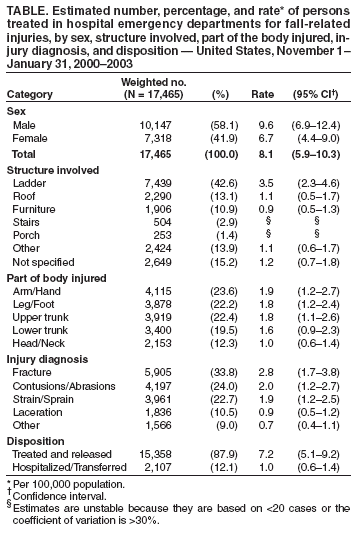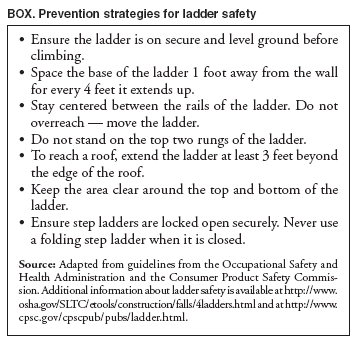 |
|
|
|
|
|
|
| ||||||||||
|
|
|
|
|
|
|
||||
| ||||||||||
|
|
|
|
|
Persons using assistive technology might not be able to fully access information in this file. For assistance, please send e-mail to: mmwrq@cdc.gov. Type 508 Accommodation and the title of the report in the subject line of e-mail. Fall-Related Injuries During the Holiday Season --- United States, 2000--2003Although fall-related injuries occur throughout the year (1), few studies have analyzed seasonal patterns (2--4), and none have examined the extent of such injuries associated with holiday decorating. To characterize nonfatal fall injuries associated with decorating or related activities, CDC analyzed data from the National Electronic Injury Surveillance System All Injury Program (NEISS-AIP) for three winter holiday seasons. This report summarizes the results of that analysis, which indicated that, during 2000--2003, an estimated 17,465 persons were treated in U.S. hospital emergency departments (EDs) for holiday-decorating--related falls. Approximately 62% of those injured were aged 20--49 years; approximately 43% of injuries were caused by falls from ladders; and males were 40% more likely than females to be injured. Prevention strategies should focus on raising awareness about falls and promoting safety practices during the holiday season. For this analysis, the holiday season was defined as November 1--January 31, when decorating or related activities (e.g., stringing and removing outdoor lights) usually occur. A fall-related injury was defined as one received when a person descended because of the force of gravity and struck a surface at the same or lower level. A case was defined as an unintentional fall-related injury that occurred to a person during the holiday season and included a product description (e.g., holiday lights) or a brief narrative in the NEISS-AIP database that listed decorating or a related activity as contributing to the injury. To characterize these injuries, NEISS-AIP data were analyzed for three holiday seasons combined (i.e., November 1, 2000--January 31, 2001; November 1, 2001--January 31, 2002; and November 1, 2002--January 31, 2003). NEISS-AIP, operated by the Consumer Product Safety Commission, collects data about initial visits for all types and causes of injuries treated in U.S. EDs. These data are drawn from a nationally representative subsample of 66 of 100 NEISS-AIP hospitals selected as a stratified probability sample of hospitals in the United States (5). Data are collected from medical records, and the most severe injury is recorded for each case. Data for each case include a two-line narrative about information regarding the circumstances of the injury. Data were weighted by the inverse probability of selection and summed to produce national estimates. Confidence intervals (CIs) were calculated by using a direct variance estimation procedure that accounted for the sample weights and complex sample design. Denominators for rates were calculated by summing the proportional fraction of the population for each year, based on U.S. Census population estimates (6). During 2000--2003, a total of 225 fall-related injuries that occurred to persons treated in participating EDs were attributed to holiday decorating or related activities, yielding a weighted national estimate of 17,465 (95% CI = 12,751--22,179) injuries, an average of 5,822 injuries per season. The overall injury rate was 8.1 per 100,000 population (CI = 5.9--10.3). The majority of injuries (62%) occurred to persons aged 20--49 years. Persons aged >49 years sustained 24%, and persons aged 0--19 years sustained 15% of fall-related injuries. Males sustained more injuries than females (58% versus 42%, respectively), although the rates for males (9.6) and females (6.7) did not differ significantly (relative rate [RR] = 1.4; CI = 0.8--2.1) (Table). The majority of falls were from ladders (e.g., while hanging holiday lights), followed by roofs (e.g., while mounting an artificial Christmas tree on the roof), furniture (e.g., while standing on a table decorating a Christmas tree, standing on a chair hanging holiday decorations, or standing on a step stool when hanging a tree topper), stairs, and porches. Other falls were caused by tripping over or slipping on holiday-related objects (e.g., tree skirts or ornaments). Among 46% of injured persons, injuries occurred to the extremities (i.e., arm/hand and leg/foot); most persons (88%) examined in EDs were treated and released, and 12% were hospitalized. Fractures were the most commonly reported injury (34%); approximately half (51%) of the fractures were caused by falls from ladders. Of those who fell from ladders, nearly half (47%) were hospitalized. Circumstances and outcomes differed by sex. Males were significantly more likely than females to sustain injuries falling from ladders (RR = 2.4; CI = 1.0--3.7; p = 0.05) or from ladders and roofs combined (RR = 3.1; CI = 1.8--4.5; p = 0.002.) For both males and females, rates for types of injuries were highest for fractures (3.5 and 2.0, respectively). Although males were at higher risk than females for sustaining fractures, the difference was not statistically significant. Reported by: JA Stevens, PhD, Div of Unintentional Injury Prevention; M Vajani, MPH, Office of Statistics and Programming, National Center for Injury Prevention and Control, CDC. Editorial Note:This is the first study to provide national estimates of fall-related injuries associated with holiday decorating or related activities. The findings in this report indicate that approximately 5,800 persons each year were treated in hospital EDs during the holiday period for these injuries. Males were 40% more likely than females to be injured in falls. The majority of cases (62%) occurred among young and middle-aged adults. In contrast, adults aged 20--49 years account for only 30% of persons treated for all fall-related injuries annually (1). In addition, 12% of patients were hospitalized for holiday-related falls, compared with 9% hospitalized annually for fall-related injuries. Although decorating-related injuries represent less than 1% of the 1.9 million injuries from falls that occur each holiday season, most of these injuries are preventable. Approximately half the injuries (56%) were caused by falls from considerable heights (e.g., ladders and roofs), and an additional 11% were caused by falls from moderate heights (e.g., tables, chairs, beds, and step stools). Using ladders was a common risk factor for fall injuries. A recent telephone survey indicated that ladders are used by persons in 60% of households nationwide (7). The findings in this report indicated that falls from ladders accounted for nearly half of all fractures treated. Males were twice as likely as females to be injured by falls from ladders, possibly because men used ladders more frequently. The findings in this report are subject to at least three limitations. First, the number of injuries likely was underestimated because it included only those persons who were treated in hospital EDs; the study did not include persons who were treated in physician offices or other outpatient settings or persons who did not receive medical attention. Second, 15% of the narratives did not describe the product involved, and the product was classified as "not specified." Finally, although the majority of patients were treated and released, NEISS-AIP does not include information about long-term outcomes such as mobility limitation, functional impairment, need for outpatient surgery, or rehabilitation. The holiday season can be enjoyed safely by taking certain precautions to avoid falls when decorating. Heightened public awareness is a key element for reducing holiday-related injuries. Prevention strategies should focus on recognizing the possibility of falls, using ladders safely (Box, using safer alternatives such as step stools instead of furniture when hanging decorations, and increasing awareness of seasonal fall hazards. Safety practiced during the holiday season also might improve safety throughout the year. References
Table  Return to top. Box  Return to top.
Disclaimer All MMWR HTML versions of articles are electronic conversions from ASCII text into HTML. This conversion may have resulted in character translation or format errors in the HTML version. Users should not rely on this HTML document, but are referred to the electronic PDF version and/or the original MMWR paper copy for the official text, figures, and tables. An original paper copy of this issue can be obtained from the Superintendent of Documents, U.S. Government Printing Office (GPO), Washington, DC 20402-9371; telephone: (202) 512-1800. Contact GPO for current prices. **Questions or messages regarding errors in formatting should be addressed to mmwrq@cdc.gov.Page converted: 12/9/2004 |
|||||||||
This page last reviewed 12/9/2004
|